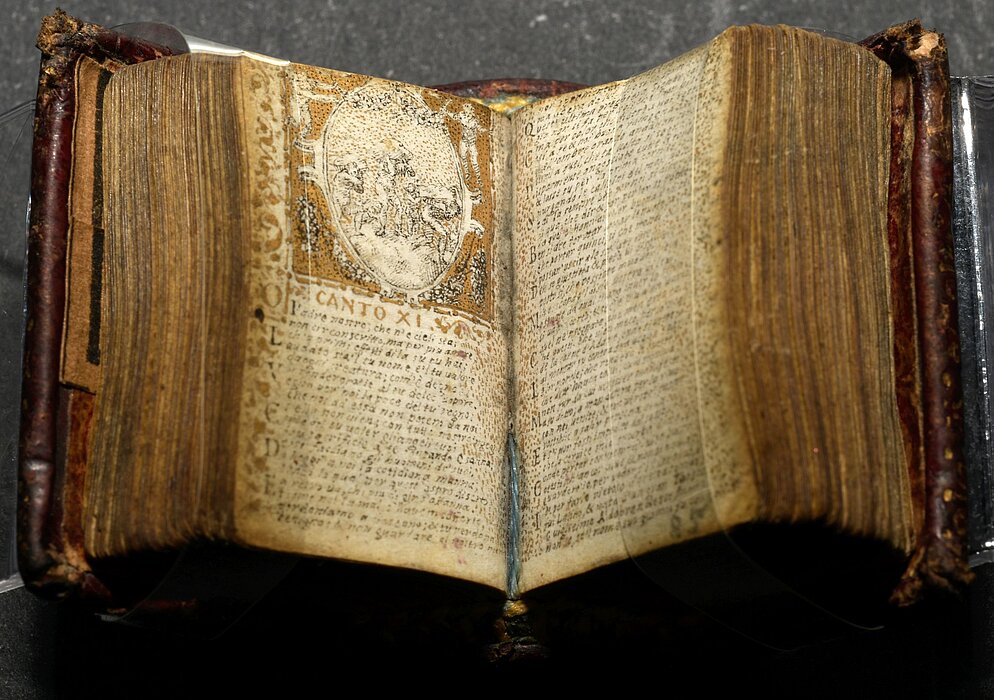Table of Contents
ToggleIntroduction
One of the most extraordinary artifacts housed in the Austrian National Library is a tiny manuscript from the sixteenth century. Measuring a mere 24 x 15 mm with a thickness of approximately 18 mm, this miniature parchment manuscript contains Dante Alighieri’s Divine Comedy, one of the most important works in world literature. Its delicate craftsmanship, including minuscule text and intricate pen drawings, makes it one of the rarest literary treasures in existence.
Historical Significance
This manuscript, dating back to the Renaissance, is a remarkable example of the period’s fascination with precision and artistic excellence. The Renaissance, a time of flourishing arts, science, and literature, also saw significant advancements in optics. The use of magnifying glasses enabled artisans to create detailed miniature works, as seen in this manuscript.

Crafted with meticulous care, this manuscript represents not just literary tradition, but also the technical ingenuity of its time. Its production reflects a growing interest in precision, miniaturization, and the luxury of owning such an intricate, portable item. Miniature books were often considered status symbols or valuable personal items, carried by aristocrats, scholars, or religious devotees.
Craftsmanship and Artistic Achievement
The manuscript’s tiny dimensions are a testament to the incredible skill of its creator. Measuring just 24 x 15 mm per page, the text is nearly impossible to read without magnification. The manuscript contains around 11 lines of text per page, written in a font so small that it is difficult to discern with the naked eye. In addition, the book includes approximately 30 delicate pen drawings, which, like the writing, were likely created under a magnifying glass.
The level of craftsmanship required to execute both the writing and illustrations on such a small scale is extraordinary. The pen drawings mirror the epic narrative of Dante’s Divine Comedy, depicting scenes from his journey through Hell, Purgatory, and Paradise. These drawings are not merely decorative; they add depth to the literary work, embodying the Renaissance era’s devotion to combining art and literature.
A Rare Treasure in the Austrian National Library
The manuscript is considered the smallest book in the Austrian National Library and remains a treasured artifact due to its rarity and artistic merit. Its survival through centuries is a testament to the reverence with which it has been treated. Despite its size, it holds immense cultural and historical value, providing insight into the Renaissance’s love for literature, art, and fine craftsmanship.
Symbolism and Purpose
This miniature manuscript may have served a dual purpose: as a display of artistic mastery and as a portable devotional object. During the Renaissance, luxury items like this manuscript were often symbols of wealth and intellectual prowess. Its small size made it easily portable, allowing its owner to carry Dante’s epic with them wherever they went, perhaps for personal reflection or religious devotion.

Moreover, the inclusion of The Divine Comedy—a work that deals with the themes of sin, redemption, and the afterlife—enhances its spiritual significance. The intricate details of both the text and the accompanying drawings suggest that the manuscript was created with deep reverence for its subject matter, offering a personal connection to Dante’s journey through the realms of the dead.
Conclusion
The sixteenth-century miniature manuscript of Dante’s Divine Comedy is far more than just a tiny book; it is a marvel of Renaissance craftsmanship, a symbol of artistic and literary achievement, and a treasure of historical significance. Its survival over the centuries underscores its value as both an artistic masterpiece and a testament to the technical prowess of its time. As one of the rarest artifacts in the Austrian National Library, it offers us a unique window into the past, where literature, art, and precision were intertwined in the creation of such remarkable objects.

